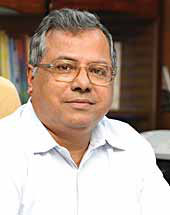Issue No.16 / October 16-31,2015

After its Make in India campaign, the Indian government is said to be pushing for a ‘Study in India’ initiative, to make India an attractive destination for education for students from across the globe
After the ‘Make in India’ move initiated by the present government, `Study in India’ is the next move that the BJP government is planning in the days ahead. As per this plan, the government will hand pick some universities that can attract foreign students to Indian educational institutions, and more importantly, which can also meet the requirements of foreign students
According to sources in the Ministry of Human Resource Development, the ministry has sought inputs from some universities on promoting foreign students to come to India for higher education. The objective is to reach out to foreign students and promote India as an education destination
This will be part of the New Education Policy that the government is drafting. A few universities which are fit to host international students and provide them with good academic infrastructure will be selected.
Speaking on condition of anonymity, an official from Manipal University said, “Our inputs in this regard have been forwarded to the Ministry.” Manipal University is one of the many universities which have been catering to foreign students from across the world on their campus.
Manipal University has many options for these students, right from the undergraduate course. Fifteen percent of the seats have been earmarked for overseas students under the foreign/Non-Resident Indians (NRI) category which include foreign citizens, Person of Indian Origin (PIO) card holders, OCI (Overseas Citizens of India). For 75 seats in its medical programs, Manipal University receives 300 applications from the world over.
But a facelift would be needed at this juncture, and universities will have to upgrade their infrastructure in terms of classrooms, hostel accommodation, and better student-teacher ratio.
As per a 2014 report of the UNESCO Institute for Statistics (UIS), India is gradually emerging as a preferred destination for foreign students, particularly from the South Asian region. The growth in the number of foreign students in India has been impressive.
As per the latest data (2011-12) available, India received 5625 students, an increase of almost 20.43 percent over last year.
In 2011, India attracted students from 153 different countries. It expanded not only in terms of the number of students but also the number of countries from which these students come.
According to the All India Survey on Higher Education (AISHE) 2011-12, Nepal contributed the highest percentage of foreign students in India. Of the total number of foreign students, nearly 19 per cent were from Nepal, followed by, in descending order, Bhutan, Iran, Afghanistan, Malaysia, Sudan and Iraq. Even though the share of foreign students from the top ten countries has increased in a year’s time, the rise is not uniform
India is also gradually emerging as a hub for post-secondary education in the South Asian Association for Regional Cooperation (SAARC) region as it has a relatively large higher education system and capacity to absorb students from neighbouring countries.
For instance, India received the highest number (92 percent) of students for nursing from Nepal and the remaining were from 23 other countries. However, Afghanistan was the highest contributor for enrolment in commerce (13 percent) and the remaining students came from 74 other countries. Corporate Citizen spoke to eminent educationists about the entire programme.
After ‘Make in India’ and ‘Skilling India’, the government has come up with ‘Study in India
The HRD ministry has sought inputs to bring more foreign students into India
Govt. to select a few universities that are fit to host international students
A fifth of the foreign students are from Nepal, followed by Bhutan, Iran, Afghanistan, Malaysia

I think it’ll be a great initiative. If handled carefully, it can prove to be a great image booster for the country as well as the brand IIT which has already made a name for itself in the world for being India’s fi nest technical education chain to which millions of youngsters aspire every year. It’s not true that foreign students do not come to IITs at all. They do come but the numbers are not very encouraging at the moment, though the situation has improved a lot since 2000 or so. Moreover, those who come here mostly join the M Tech or other PG level programme, or research. But the question is: why is it that not many from the US or western nations come to India for higher technical education? I think, we must realize that we have to go miles before we get the same kind of environment and ecosystem for research as it exists in most western countries. I mean -- except for the IITs, AIIMS and the IIMs -- the way research is carried out in most of our universities leaves much to be desired. But with more and more institutions of higher learning, backed by top corporate houses and world class faculty coming up fast in the private sector, things have started looking brighter. So, keeping in mind the changing scenario, I feel, it’ll be great if the PM takes up this bold and laudable initiative for attracting more and more foreign students to the best of our technical institutions. I, however, don’t think that foreign students will come to India only because of the cost benefit in terms of much lesser fees as compared to the western nations. I think they will come to India because the intellectual capability of our people is very strong, and acknowledged the world over by one and all. In fact, they are bringing a huge, cultural change also in the way the westerners think about India and its people.

This is a very good move and I hope it comes true. We have the best of the institutions in all fi elds of academics, be it engineering, electronics, medicine and teaching professions. I am not aware of it, but it is one of the best that could happen. And I am sure many of the overseas students will grab the opportunity, as our country is the cheapest compared to other European countries, and we will provide them with the best.

This is a wonderful idea as we have top class institutions and it is a very good move if it comes through. The level of competition in education also will peak and the outcome of the results would enhance students’ career further. What is more important is that the cost of education is much cheaper here compared to other countries around the globe. I am sure we can give the students top level career benefi ts, as there are very good private and government colleges which will cater to the students.

India a land of rich cultural heritage, history of having Centers of Learning like Buddhist Monasteries which have existed since 7th century BC, Nalanda and Takshashila in the 3rd century AD attracting foreign scholars in those centuries has sadly ignored that soft power diplomacy plays an integral part of the Foreign Policy of any Country. Th e extension of Make In India policy of the government to “Study In India” to attract Foreign students to India is a welcome change. India a Provider to the World Knowledge pool in IT, could also be a natural choice for Developing and Neighboring countries-SAARC, ASEAN, Middle East, Africa. India has the potential to attract students from these countries as it has the Global Recognition ,medium of Instruction is English the Universally accepted language has Comparatively Moderate Fees & Cost of Living and a welcoming Environment. However we have not been very successful in exploiting these positive advantages to its benefit, to add we have also played a very dismal role in attracting the Indian youth diaspora to India considering the fact that India has more than 28 millionIndians living abroad. (http://moia.gov. in/writereaddata/pdf/Population_Overseas_ Indian.pdf–2015)
There are two aspects of attracting Foreign students to India: a) Long term to pursue Post Graduate, Under Graduate studies in India; b) Attract students short term programs like Study India Programs, Internships, Summer Schools
There are many challenges that India needs to overcome with respect to Foreign Registrations, Infrastructure, teaching methodologies, changing the regulatory structure in the current higher education system to facilitate Internationalization of higher education, designing International Curricula to meet global demands, designing and providing inter disciplinary courses. There are many measures that could be undertaken to create awareness of Indian Higher Education like hosting Educational Fairs, Promotions through websites, increasing Quota for foreign students, offering more opportunities for Scholarships for students from developing countries, better student support system by having International offices at Universities. Attracting foreign students to come on short term programs like Study India Programs is a very good option. These programs act like curtain raisers for students to get an glimpse of India- its socio cultural aspects, Political and economic scenario, Technological developments in India, Role of Women, History and Mythology. It is observed that in majority cases the students who come on these programs have preconceived/prejudiced views and return back to their countries with a totally transformed view about India. These programs also induce students to come back to India to pursue studies for longer terms. The initiative taken by the Ministry of Overseas Indian Affairs to promote Brand India by offering scholarships to the youth Diaspora to come to India for short term on these Study India Programs needs to be applauded however more initiatives need to be taken towards this. India has a huge Industrial, Technological base and foreign students should be attracted to do short term internships in these Industries. These internships will also go a long way in inculcating intercultural competencies which will enhance their employability skills. These internships could also be provided to work in NGO’s towards community engagement and social responsibility. Symbiosis international University has been attracting students from developed countries for the Study India Programme. This programme is generally between four- six weeks. The students are not only exposed to Indian business, history, culture through classroom lectures but are also taken on field trips and internships in Indian corporates are also facilitated.
Attracting foreign students to come on short term programmes like `India Programs’s is a very good option. These programs act like curtain raisers for students to get a glimpse of India- its socio cultural aspects, political and economic scenario, technologicaldevelopments in India, role of women,history and mythology

Iam quite optimistic about the ‘Make in India’ campaign with a rider, however, that we have to work on our pitiable ranks in ‘Ease of Doing Business’ and ‘Corruption Index’. But, here again, a better appreciation of the situation is needed. It is not the central government that is the villain vis-a- vis these terrible scores; rather it is mostly the state governments. That is where most of the bottlenecks and corruption spots are. It should further be noted that most of these bottlenecks and black grease are at the lower levels – at the ‘babu’ class level. But all is not lost! They could be won over if there is a determined effort to educate and re-orient them to economic activities and development. A German psychologist once used an expression ‘mental revolution’ in the context of employee motivation and commitment. We need such a ‘mental revolution’ among our government officers and staff of local bodies towards facilitating and supporting economic development. I would not be all that optimistic when it comes to the new initiative of ‘Study in India’. It is indeed a good idea and something worth pursuing. But the odds against it are rather heavy! Consider the following issues, for example:
Some of our private institutions have come up very well: VIT in Vellore, Manipal University, SMR University in Chennai, Symbiosis in Pune, Birla Institute of Technology Pilani, Th apar University, Patiala, Nirma University, Ahmedabad, XLRI in Jamshedpur, SP Jain Institute in Mumbai, Azim Premji University in Bangalore, MDI Gurgaon, and many such examples.
‘Study in India’ is a very sophisticated kind of business. The government is ill equipped to handle it. Entrust it to good private sector institutions, including some well established business houses. The government should then play the role expected of them –facilitation. It would work then.
By Joe Williams